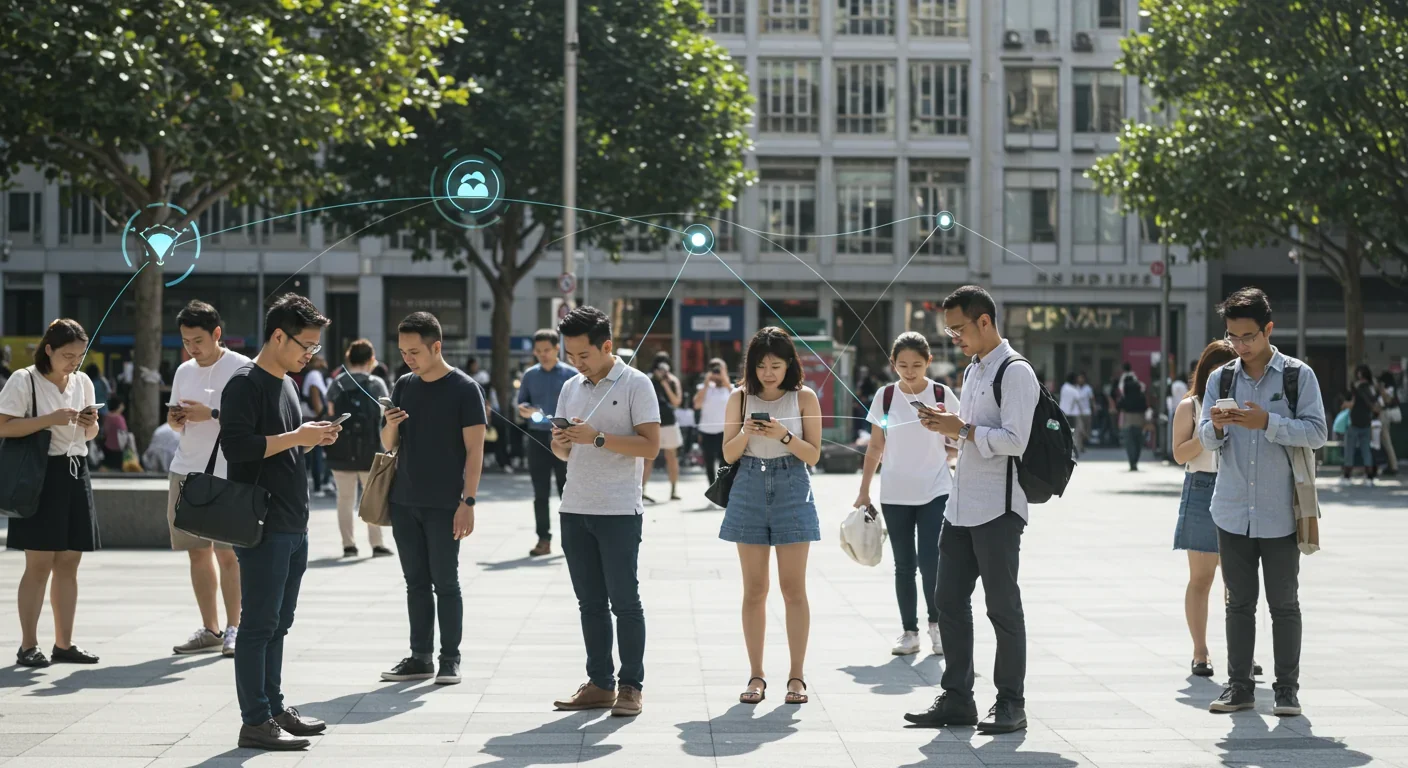Why Your Brain Sees Gods and Ghosts in Random Events

TL;DR: Social contagion—the rapid spread of behaviors, emotions, and beliefs through networks—shapes everything from viral memes to financial crashes. Powered by mirror neurons and turbocharged by algorithms, contagion can tip behaviors viral once critical thresholds are reached. While it enables positive cascades like public health campaigns spreading across communities, it also fuels misinformation, mass panic, and algorithmic radicalization. Understanding network science, developing resistance skills, and designing contagion-aware interventions are essential for navigating a future where ideas spread faster than ever.

In 2020, as COVID-19 lockdowns swept the globe, a curious phenomenon emerged: otherwise rational people began stockpiling toilet paper with the fervor of doomsday preppers. Store shelves emptied within hours. Fistfights erupted in supermarket aisles. Yet there was never an actual toilet paper shortage—until panic buying created one. This wasn't mere coincidence. It was social contagion in action, a powerful psychological force that transforms individual behaviors into mass movements faster than any virus.
Social contagion—the spontaneous spread of emotions, beliefs, and behaviors through networks—shapes our world in ways most people never recognize. It's the invisible hand behind viral TikTok dances, financial bubbles, suicide clusters following celebrity deaths, and the alarming velocity at which misinformation outpaces truth online. Just as the printing press democratized knowledge and reshaped civilization, today's algorithmic social networks have turbocharged contagion, creating feedback loops that can elevate a niche meme to global phenomenon in hours or plunge markets into chaos with a single tweet.
For decades, the phrase "six degrees of separation" has captured our imagination—the idea that any two people on Earth are connected by a chain of roughly six acquaintances. In 2023, researchers at Bar-Ilan University proved this mathematically, showing that individual pursuit of social centrality—our drive to be well-connected while limiting friendship costs—inevitably produces network structures with an average path length of six. Facebook's own data confirms this: among 1.6 billion users in 2016, the average separation dropped to just 4.57 degrees.
These short paths aren't curiosities; they're highways for contagion. Within six infection cycles, a virus can circle the globe. Within six friendship hops, an idea can reach billions. Network science reveals that vaccination effectiveness—and by extension, any intervention against contagion—works universally across different network structures, whether tightly clustered communities or randomly connected individuals. The same principles governing measles outbreaks in contact networks apply to misinformation spreading through Twitter's 4.67-degree separation or LinkedIn's deliberately engineered three-tier connection system.
Deep learning models now predict which early transmission chains will "take off" versus "die out" with over 90% accuracy by analyzing both network topology and temporal dynamics. These models, pre-trained on simulated epidemics and fine-tuned on real outbreak data, improve prediction accuracy by 3–5% compared to traditional methods—a margin that could save thousands of lives or prevent billions in economic damage from financial contagion.
Social contagion isn't new; only its velocity has changed. In July 1518, Strasbourg witnessed one of history's most bizarre outbreaks: hundreds of people danced uncontrollably for days, some until collapse or death. Modern historians recognize this "dancing plague" as mass psychogenic illness (MPI)—physical symptoms spreading through a population with no infectious agent, driven purely by social and psychological factors.
Similar patterns recur across centuries. The 1688 Irish Fright saw false rumors of Irish soldiers massacring English towns trigger mass panic across 19 counties. In 1973–78, nine MPI outbreaks struck Singapore factories, predominantly affecting young women; tellingly, traditional exorcisms often exacerbated rather than resolved these episodes. The notorious "June Bug" outbreak in 1962 saw 62 textile workers—59 of them women—report severe nausea and skin eruptions despite medical investigators finding no pathogen.
What changed with the internet wasn't the mechanism but the scale and speed. Pre-digital contagion required physical proximity or mass media amplification. The 1967 Milgram experiment—where packages forwarded through personal networks took an average of six steps to reach their destination—moved at the pace of postal mail. Today, a teenager in Manila can trigger a global challenge that reaches New York, Lagos, and Mumbai simultaneously. The 2015 Charlie Charlie Challenge—a viral Ouija-board-style game—hospitalized teens across Colombia and the Dominican Republic within days, a textbook case of digitally accelerated MPI.
The lesson from history is clear: humans have always been susceptible to behavioral cascades. Technology merely determines whether contagion spreads at the speed of a letter, a television broadcast, or an algorithm.
At its core, social contagion operates through identifiable psychological and neurological pathways. Mirror neurons—brain cells that fire both when we perform an action and when we observe others doing it—provide the biological substrate for emotional mimicry. Neuroimaging studies show identical brain regions activate whether you smile or watch someone else smile, creating an internal simulation that fosters empathy and synchronization.
This automatic mimicry follows a two-step process: first, we unconsciously imitate others' expressions, vocalizations, and postures; second, our own emotional state shifts to match the signals we're broadcasting. This isn't conscious decision-making—it's a deeply wired survival mechanism observed across species, from rats ceasing lever-presses after witnessing a partner receive electric shocks to dogs exhibiting increased cortisol when exposed to human fear-sweat.

But modern contagion adds algorithmic amplification to biological predisposition. Platform reward systems create habitual sharing patterns that activate automatically, bypassing critical evaluation. A University of Southern California study of 2,476 Facebook users found that habitual sharers—just 15% of users—accounted for 30–40% of all fake news shared, and they spread misinformation six times more than occasional users. Critically, these habitual sharers posted fake news even when it contradicted their stated political beliefs, indicating disengaged, automatic processing rather than ideological commitment.
Algorithms exploit this by prioritizing engagement over accuracy. Content that triggers high-arousal emotions—awe, anger, amusement, fear—receives algorithmic boosting, creating feedback loops where emotionally provocative material dominates feeds. A 2023 audit of Twitter's engagement-based ranking found it amplified emotionally charged, out-group hostile political content that users explicitly said made them feel worse about their political opponents, yet the algorithm persisted because such content drove clicks and time-on-platform.
Threshold models formalize when behaviors tip from niche to viral. Simple contagion—like cars slowing on a highway—requires just one exposure. Complex contagion—adopting solar panels, joining a protest movement—demands multiple reinforcing signals, typically from close ties. Research tracking solar panel adoption in California neighborhoods demonstrated cascading diffusion: once a critical mass of neighbors installed panels, adoption rates surged across the entire community.
Social contagion is fundamentally restructuring how information, commerce, and culture flow through society. Industries built on attention—advertising, media, entertainment, politics—now operate in an environment where virality often trumps quality and algorithmic reach determines success more than merit.
Marketing has transformed from broadcast messaging to contagion engineering. Brands no longer just advertise; they design "social proof" into every touchpoint. A one-star increase in product ratings boosts sales 7–9%, according to Harvard Business School research. Real-time social proof notifications—"23 people are viewing this item"—leverage FOMO (fear of missing out) and bandwagon effects to drive conversion. The challenge is sustainability: 84% of consumers discount social proof older than three months, requiring constant refresh to maintain effectiveness.
The job market reflects this shift. "Influencer" emerged as a profession in the 2010s; by 2025, influencer marketing is a $21 billion industry. But counter-intuitively, research shows ordinary users with modest followings often spread content more efficiently than mega-influencers, whose audiences suffer attention overload. This has spawned micro-influencer strategies and peer-to-peer marketing that weaponize weak ties and structural holes in networks—the bridges between otherwise disconnected communities that control information flow.
Public health now explicitly harnesses positive contagion. The "Hearts for Heart Health" campaigns analyzed 73,288 tweets across five years, identifying central hashtags like #OurHearts and #AmericanHeartMonth that acted as hubs linking sub-communities. By targeting these high-betweenness nodes—positions that bridge otherwise separate groups—public health practitioners amplify messages across diverse audiences exponentially faster than blanket advertising.
Culturally, we're witnessing the fragmentation paradox: algorithms that promise personalization instead create homogeneous filter bubbles where everyone sees a different internet, each tailored to confirm pre-existing beliefs. Agent-based modeling demonstrates that polarization emerges only when both network homophily (tendency to connect with similar others) and algorithmic filtering are present simultaneously—neither alone produces the same magnitude of division. More than 60% of Facebook users are unaware their feeds are algorithmically curated, believing they see everything their friends post, when in reality the algorithm reduces politically cross-cutting content by 5% for conservatives and 8% for liberals.
Social contagion isn't inherently destructive; it's a neutral force that amplifies whatever behaviors it touches. Properly harnessed, it offers unprecedented opportunities to spread beneficial behaviors at scale and speed traditional methods can't match.
Public health campaigns leveraging social contagion have achieved remarkable success. Social norm marketing—simply informing people that "most of your neighbors conserve energy" or "most students drink moderately"—has reduced energy consumption by 30% and binge drinking by measurable percentages. A hotel towel reuse experiment found that social proof messaging ("75% of guests reuse towels") increased reuse from 35.1% to 44.1%, outperforming environmental appeals.
The Framingham Heart Study revealed that happiness spreads through networks up to three degrees of separation: if a friend living within one mile becomes happy, your likelihood of happiness increases 25%. This "three degrees of influence" rule suggests that targeted interventions—making key network nodes happier, healthier, or more civically engaged—can create cascading positive externalities far beyond the initial recipients.
Pre-bunking (or inoculation) represents a promising counter-contagion strategy. By exposing people to weakened forms of misinformation tactics before encountering them in the wild, researchers build psychological resistance. Pre-bunking interventions delay tobacco initiation among adolescents for several months, though effectiveness fades without regular booster sessions. Scaling this to group settings creates "herd immunity" against misinformation, with network members reinforcing each other's critical thinking.
For every positive application, social contagion enables equally powerful harms. Misinformation spreads faster and farther than truth online—a reality with existential implications for democracy, public health, and social cohesion.
Algorithmic amplification systematically privileges polarizing, radicalizing content over neutral civic discourse. Network Contagion Research Institute simulations of TikTok user behavior reveal how recommendation systems amplify authoritarian narratives while suppressing dissent, with heavy platform use correlating to increased favorability toward the Chinese Communist Party. Their research, cited in Supreme Court briefs and congressional debates, documents "botification"—the process by which high media consumption induces bot-like, algorithmically manipulable behavior that distorts users' internal models of self and world.
Mass psychogenic illness in the digital age presents new challenges. The 2021 outbreak of tic-like behaviors among adolescents, linked to social media exposure, led researchers to identify social media as the primary transmission vector. Havana syndrome—contested neurological symptoms affecting diplomats—shows how online support groups can amplify belief in conditions even when etiology remains unclear. Experts draw parallels to historical "shellshock," where clinic specialization inadvertently induced symptoms through suggestion and social modeling.
Suicide contagion represents the gravest risk. Agent-based modeling confirms that copycat suicides are more likely when publicized deaths share characteristics with vulnerable individuals—the "Werther effect." Media guidelines now recommend limiting detailed coverage, yet social media's decentralized nature makes such norms nearly unenforceable.
Ethical concerns abound. Facebook's 2014 experiment manipulating 689,000 users' news feeds to test emotional contagion triggered widespread backlash over consent violations and psychological manipulation. The incident highlighted a gap between scientific curiosity and human subject protection that regulation hasn't yet closed. When private platforms conduct mass behavioral experiments without disclosure or oversight, the boundary between research and manipulation dissolves.
Social contagion operates differently across cultural contexts, with collectivist and individualist societies showing divergent susceptibility patterns. Research by Cialdini and colleagues found that social proof—information about others' behavior—drives greater compliance in collectivist cultures (East Asia, Latin America), while appeals to personal consistency work better in individualist cultures (North America, Western Europe). This suggests contagion interventions must be culturally tailored to succeed.
Regulatory responses vary dramatically. The European Union's approach emphasizes platform accountability, with Digital Services Act provisions threatening fines of 6% of global turnover for algorithmic amplification of harmful content. India's Ministry of Electronics and Information Technology flagged over 9,845 URLs hosting harmful content, requiring removal within 36 hours under IT Rule 2021. In contrast, the United States has largely resisted platform regulation, relying on Section 230 protections that shield platforms from liability for user-generated content.
China offers an alternative model: state control of algorithmic recommendation systems, with platforms required to register algorithms with regulators and provide users access to non-personalized feeds. While this approach limits certain forms of viral misinformation, it also enables government censorship at unprecedented scale, raising questions about whether contagion control can exist without state surveillance.

Navigating the contagion-saturated future requires new literacies and institutional adaptations. For individuals, critical skills include network awareness—understanding your position in social networks and whether you're a bridge between communities or embedded in a tight cluster. Bridges wield disproportionate influence over what information spreads but also bear responsibility for filtering harmful content.
Contagion detection means recognizing when you're experiencing or spreading contagious behaviors. Warning signs include sudden widespread adoption of beliefs within your network, emotional intensity disproportionate to stakes, and difficulty articulating why you believe something beyond "everyone knows."
Resistance skills training through pre-bunking interventions works, but requires regular booster sessions. Cultivating habits of verification—checking sources, seeking disconfirming evidence, pausing before sharing—creates psychological immunity. Group-based resistance strengthens individual resolve through mutual reinforcement.
Algorithmic literacy means understanding that platforms don't show you reality but algorithmically curated slices optimized for engagement. Over 60% of users don't realize their feeds are filtered; awareness alone reduces susceptibility. Using "not interested" signals and actively seeking diverse sources can partially counteract filter bubbles, though research shows platforms often ignore user preferences when they conflict with engagement goals.
For organizations, the imperative is designing interventions that account for network topology. Centrality-based seeding strategies—targeting high-degree nodes, opinion leaders, and structural hole spanners—outperform random or purely demographic approaches in competitive influence diffusion games. Public health and education institutions must shift from broadcast to network-based strategies, leveraging contagion dynamics explicitly.
Policymakers face a delicate balance: curbing harmful contagion without stifling beneficial innovation or free expression. Transparency mandates—requiring platforms to disclose algorithmic ranking criteria and provide users with chronological feed options—offer a middle ground between laissez-faire and heavy-handed content moderation.
Artificial intelligence presents both threat and opportunity. AI-driven content moderation has reduced some categories of harmful content by 30%, but also risks encoding bias at scale. Conversely, large language models enable sophisticated narrative tracking, identifying emerging extremist ideologies before they reach critical mass.
The deeper question is whether human psychology can adapt to an environment where contagion operates at network speed. Our brains evolved for face-to-face interaction in groups of 150, not algorithmically mediated networks of billions. The mismatch between evolutionary design and modern environment creates exploitable vulnerabilities. Whether through education, regulation, or technology design, closing this gap is perhaps the defining challenge of the digital age.
Social contagion is neither good nor evil—it's a fundamental property of networked systems, as inevitable as gravity. What matters is whether we harness it consciously or allow it to harness us. The next time you feel an inexplicable urge to buy toilet paper, share a provocative tweet, or adopt a belief that "everyone knows" is true, pause. Ask yourself: am I thinking, or am I catching? The answer may determine more than you realize.

Recent breakthroughs in fusion technology—including 351,000-gauss magnetic fields, AI-driven plasma diagnostics, and net energy gain at the National Ignition Facility—are transforming fusion propulsion from science fiction to engineering frontier. Scientists now have a realistic pathway to accelerate spacecraft to 10% of light speed, enabling a 43-year journey to Alpha Centauri. While challenges remain in miniaturization, neutron management, and sustained operation, the physics barriers have ...

Epigenetic clocks measure DNA methylation patterns to calculate biological age, which predicts disease risk up to 30 years before symptoms appear. Landmark studies show that accelerated epigenetic aging forecasts cardiovascular disease, diabetes, and neurodegeneration with remarkable accuracy. Lifestyle interventions—Mediterranean diet, structured exercise, quality sleep, stress management—can measurably reverse biological aging, reducing epigenetic age by 1-2 years within months. Commercial ...

Data centers consumed 415 terawatt-hours of electricity in 2024 and will nearly double that by 2030, driven by AI's insatiable energy appetite. Despite tech giants' renewable pledges, actual emissions are up to 662% higher than reported due to accounting loopholes. A digital pollution tax—similar to Europe's carbon border tariff—could finally force the industry to invest in efficiency technologies like liquid cooling, waste heat recovery, and time-matched renewable power, transforming volunta...

Humans are hardwired to see invisible agents—gods, ghosts, conspiracies—thanks to the Hyperactive Agency Detection Device (HADD), an evolutionary survival mechanism that favored false alarms over fatal misses. This cognitive bias, rooted in brain regions like the temporoparietal junction and medial prefrontal cortex, generates religious beliefs, animistic worldviews, and conspiracy theories across all cultures. Understanding HADD doesn't eliminate belief, but it helps us recognize when our pa...

The bombardier beetle has perfected a chemical defense system that human engineers are still trying to replicate: a two-chamber micro-combustion engine that mixes hydroquinone and hydrogen peroxide to create explosive 100°C sprays at up to 500 pulses per second, aimed with 270-degree precision. This tiny insect's biochemical marvel is inspiring revolutionary technologies in aerospace propulsion, pharmaceutical delivery, and fire suppression. By 2030, beetle-inspired systems could position sat...

The U.S. faces a catastrophic care worker shortage driven by poverty-level wages, overwhelming burnout, and systemic undervaluation. With 99% of nursing homes hiring and 9.7 million openings projected by 2034, the crisis threatens patient safety, family stability, and economic productivity. Evidence-based solutions—wage reforms, streamlined training, technology integration, and policy enforcement—exist and work, but require sustained political will and cultural recognition that caregiving is ...

Every major AI model was trained on copyrighted text scraped without permission, triggering billion-dollar lawsuits and forcing a reckoning between innovation and creator rights. The future depends on finding balance between transformative AI development and fair compensation for the people whose work fuels it.